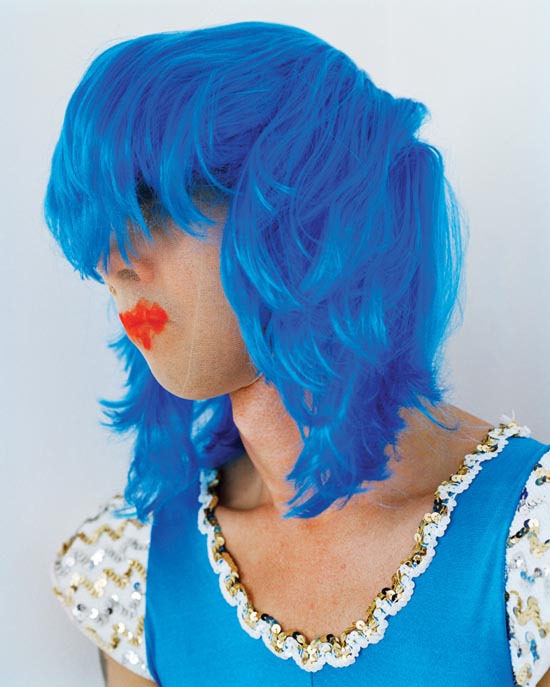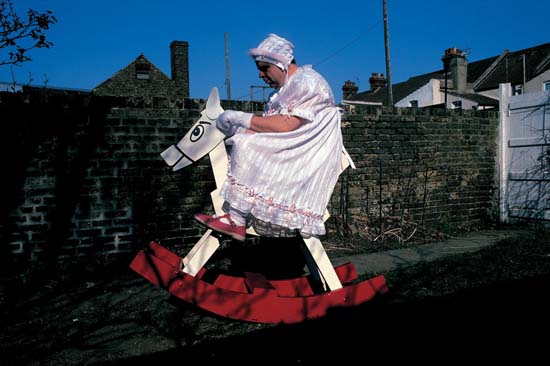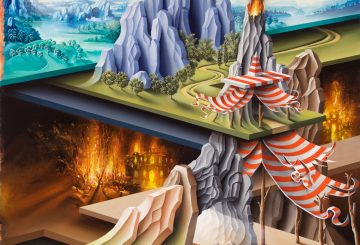Sharne Wolff takes a look at Polly Borland: Everything I Want to Be When I Grow Up and ponders royalty and grown up man-babies…
On the front cover of the October issue of Australian Art Collector is a picture of HRH the Queen. She’s standing, quite regally, amidst a blue floral background some of you will recognise as a Marimekko design. When Polly Borland was one of a small group selected to photograph the monarch for the Golden Jubilee in 2001, Borland discovered she had less than five minutes to prepare for her shots. “The experience was …surreal”, Borland relates, and she found herself unexpectedly overwhelmed, despite being very accustomed to taking pictures of celebrities. Two of the photographs, both titled Her Majesty, The Queen, Elizabeth II (one (blue) and the other (gold)), are part of Borland’s current exhibition at the University of Queensland Art Museum.
Polly Borland, Untitled (Nick cave in a blue wig) 2010. type C photograph 210x160cm.
Everything I Want to be When I Grow Up is Borland’s first major show in Australia since The Australians at The National Portrait Gallery in Canberra in 2000. Borland made her original reputation in the world of commercial photography and celebrity portraits. But don’t expect to see celebrities in this show. Although you might have seen the exhibition promo shot of a stocking-headed-almost-unrecognisable Nick Cave wearing a garish blue wig and smeared red lips, the only other celebrity photograph is one of that ‘other’ Queen Elizabeth, Cate Blanchett. Taken in 2000, Blanchett’s image is intriguing but rather more ‘down home girl’ than international celebrity. Borland now draws the line between her commercial photography and her ‘art’. The exhibition, curated by Alison Kubler, does the same.
What you will see is what has become known as the ‘mini retrospective’. This show covers four of Borland’s photographic series since 2001, mostly in ample depth. While Borland decided that on one hand she had reached the pinnacle of her career with her images of the Queen, The Babies was the project that gave Borland the opportunity to contemplate a change in style. It began as a documentary assignment for the UK’s Independent newspaper on the practice of ‘infantilism’ [where adults live out their desires to behave as babies]. At the time, the internet was not so readily available and those individuals who practised infantilism were largely hidden, even to themselves.
The Babies comprises around a dozen large unframed photographs set behind a thin layer of acrylic. Adults are dressed in nappies and baby clothes, and pictured living out their fantasies. When first viewed these pictures are quite unreal – as if someone had chosen an odd fancy dress theme for a 40th birthday party. Reactions in the viewing audience ranged from pity and horror to laughter and disbelief. These are truly raw photographs that identify first the voyeur, and later the human in all of us. Unlike those quick snaps of the Queen, Borland spent five years gaining the trust of her subjects, who were obviously sensitive to potential public ridicule, before they became confident enough to allow their photographs to be taken. Borland says that the most common story she heard from these men was that they felt unloved as children. There’s no doubt Borland has captured unrestrained emotion in her subjects from the sheer joy of Cathy, Julianne, Snuggles and Roberta in Mummy Hazel’s garden 2001 to the plea-like gaze of her subject in Julianne in the Bath at Home 2001. Darren at Home 2001 brings the reality of her subject’s predicament to the fore. Although we can’t see his face, there’s enough information to know we are looking at an adult male, complete with tatts and blistered ‘workman’s hands’. Darren sits in his nappy, holding a teddy bear to his chest. His pink dummy is just in frame.
Polly Borland, Snuggles in Mummy Hazel’s Garden 2001, from the series The Babies. Type C photograph, 121×181.5cm
The question that keeps popping into my mind is how The Babies series differs (if it does) from photojournalism. It’s as if Borland is looking over her shoulder towards some of those artists whose work has influenced her – Diane Arbus, Larry Clark, and Cindy Sherman. Choice of lighting and angle, altered focus and other elements in these photographs demonstrate Borland searching for an aesthetic. She shoots with film and always selects her preferred images from a printed proof sheet. According to Borland glamorous can be rather ‘boring’. She has always been more interested in exploring the interesting side of the people in her portraits.
The benefit of this retrospective in a large space like UQAM is that it enables the audience to see the entire body of work, while simultaneously allowing viewing of the photographs in their individual series’. The beginnings of the transformation in Borland’s practice become obvious in the next sequence of work entitled Bunny, where Borland again spent time with her subject, a tall blonde woman named Gwendolyn. We see Gwendolyn in numerous poses (sexy, erotic, curious, naked, painted with red spots) many of which consider the tradition of depicting beauty. They also evidence Borland’s determination to seek the more edgy and quirky approach with her images. Works like Untitled I, III and XVII, where the subject disappears behind her home-fashioned ‘costume’, are the real genesis of the next series’ of Borland’s works Smudge.
In 2010 Borland gathered together some props and rang a couple of friends to shoot the images for Smudge. She prepares beforehand although the dressing up and poses are playful and usually quite spontaneous. Although it’s not really evident from the photos, one of her subjects was her good friend, Nick Cave, who apparently doesn’t like to have his photo taken. Borland told him she was interested in his shape and angular features and not his celebrity, or his face.
With the use of unexpected props – lots of stuffed stockings, ping pong balls, wigs, pom poms, red lipstick, plastic appendages and the odd slice of cucumber (or something?) Borland has completely altered the appearance of her subjects. The creation of these new forms means her human sculptures transcend the photographs in which they appear. The use of Cave here is, of course, also a clever move. Even if unintended, it forces us to think about the usual image of celebrity. They’re reminiscent of film stills in that they approach performance – there’s a sense that the subject is caught in the act of doing something. To describe them isn’t easy – they’re alternately weird and wacky, sad, wild and sometimes even sexy and erotic. They’re uncomfortable but they’re also funny. Paradoxically as Borland’s portraits have become further removed from reality they might have edged closer to other ‘truths’. According to Cave on Smudge, “…Polly seems to me to be shooting into a distorted mirror and simply bringing back heartbreaking refracted images of herself.” As you do say, to a friend.
In Borland’s latest foray, Pupa, (also recently shown at Murray White room in Melbourne) the work has become far more abstracted. She’s continued to deal with the figure, albeit as a ‘non-human’ and with the use of mirrors and glass. There’s also more stockings – stuffed and skin coloured, the artist has transformed them into biomorphic ‘creatures’ and unidentifiable body parts which are juxtaposed against mirrors at weird angles, creating a symmetry of sorts. It’s hard to know what you’re looking at here and the unreal fleshy forms render these images with a creepy, unpleasant appearance. The title of the series means ‘an insect: in the transformation stage’ which sheds light on the forms identified, Borland’s practice and perhaps also the artist herself. For many reasons this is an unforgettable show.
Polly Borland: Everything I Want to be When I Grow Up.
University of Queensland Art Museum, Brisbane
Until November 25, 2012.



